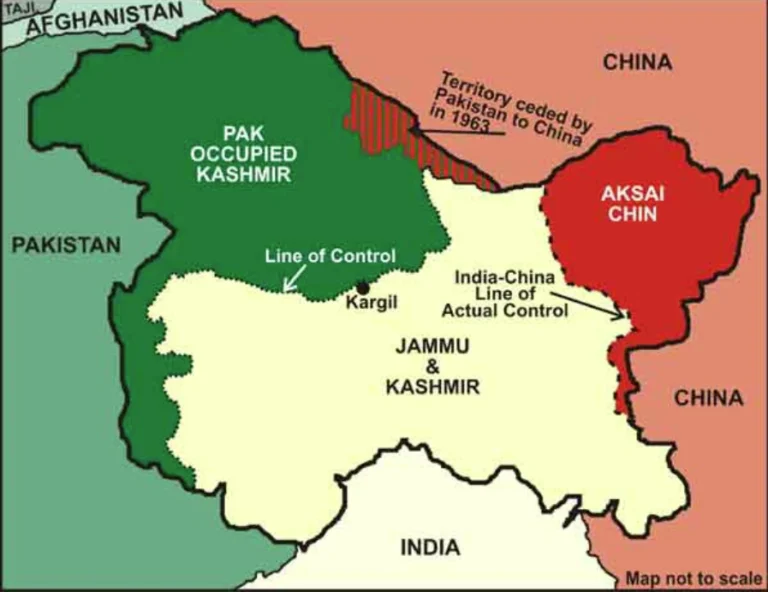The Line of Control LoC is one of the most significant and sensitive military boundaries in South Asia. It serves as the de facto border between Indian-administered Jammu and Kashmir and Pakistan-administered Azad Jammu and Kashmir and Gilgit-Baltistan. Unlike an internationally recognized border, the LoC is a military control line that arose out of historical conflict and remains a flashpoint for ongoing tension between the two nuclear-armed neighbors, India and Pakistan.
The origin of the Line of Control dates back to the turbulent period following the partition of British India in 1947. The princely state of Jammu and Kashmir became a disputed territory between India and Pakistan, leading to the first Indo-Pakistani War in 1947-48. This war ended with a ceasefire brokered by the United Nations in 1949, which established a ceasefire line dividing the territory into two parts controlled by the opposing sides. This ceasefire line was the precursor to what would later become the Line of Control.
In 1972, following the Indo-Pakistani War of 1971 and the subsequent Simla Agreement, the ceasefire line was formally renamed the Line of Control. The agreement aimed to establish peaceful relations and respect for the status quo in Kashmir, but it did not resolve the underlying dispute. The LoC runs approximately 740 kilometers (about 460 miles) through difficult and often mountainous terrain. It cuts through valleys, hills, and forests, separating communities and families and making it one of the most militarized borders in the world.
The military and strategic significance of the Line of Control LoC cannot be overstated. Both India and Pakistan have heavily fortified their sides of the LoC with soldiers, bunkers, artillery, and surveillance systems. The region experiences frequent ceasefire violations, with both sides accusing each other of firing across the line, leading to casualties among soldiers and civilians. Skirmishes and exchanges of fire along the LoC occur regularly, raising tensions and sometimes escalating into larger military confrontations.
One of the major challenges in the region is the infiltration of militants across the LoC from Pakistan-administered Kashmir into Indian-administered Kashmir. India has accused Pakistan of supporting and sponsoring these militant groups, which Pakistan denies. This cycle of cross-border violence has been a key factor in the ongoing conflict and instability in the Kashmir region.
Ceasefire agreements have been attempted to reduce hostilities along the LoC. The most recent ceasefire was agreed upon in February 2021, with both countries pledging to respect the ceasefire and avoid any actions that might escalate tensions. Despite such agreements, violations have continued, undermining trust and making peace efforts difficult. The Line of Control remains a heavily contested and closely watched boundary.
The impact of the LoC is not limited to military and political aspects. Civilians living near the Line of Control often suffer greatly due to the violence. Many families have been displaced multiple times as a result of shelling and fighting near the border. Infrastructure such as schools, hospitals, and homes are frequently damaged or destroyed. The constant threat of violence affects the mental health and livelihood of residents in these border areas.
Economic and social development in regions near the Line of Control is often hindered by security concerns and restrictions on movement. Cross-border trade and communication remain limited or nonexistent, contributing to the isolation of these communities. The division created by the LoC has separated many families and cultural groups who once lived together peacefully, deepening the human cost of this long-standing conflict.
Despite the volatility and challenges, there are ongoing diplomatic efforts by both India and Pakistan to manage the situation along the LoC. Communication channels, including a military hotline, are maintained to prevent accidental escalation and to address violations quickly. International actors and organizations have also called for restraint and dialogue between the two countries.
The Line of Control LoC is not just a physical boundary but also a symbol of the unresolved conflict between India and Pakistan. Its existence reflects decades of political tension, military conflict, and failed peace efforts. The future of the region remains uncertain, as both countries continue to assert their claims and prepare for potential confrontations. The situation along the LoC is a complex mix of military strategy, national pride, human suffering, and diplomatic efforts, making it one of the most closely monitored and sensitive lines on the global map.







